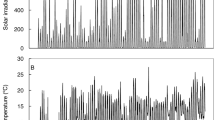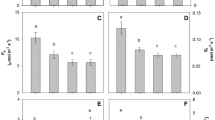Abstract
The objective of this study was to determine the effect of short-term low temperature on the concentration of phenolic antioxidant compounds in kale. For the low-temperature treatment, two kale cultivars (‘Manchoo Collard’ and ‘TBC’) grown for 3 weeks in a growth chamber were subjected to 4°C for 3 days, and subsequently allowed to recover for 2 days under normal growth conditions (20°C). Fresh and dry shoot and root weights, chlorophyll fluorescence (potential quantum yield in dark-adapted conditions), reactive oxygen species (O2 ·- and H2O2), total phenolic concentration, antioxidant capacity, individual phenolics, and phenylalanine ammonia-lyase (PAL) activity were measured before and after treatment. No significant difference was observed between the control and low-temperature treatments in the fresh or dry shoot or root weights of either cultivar. The Fv/Fm decreased during the low-temperature treatment in both cultivars, and O2 ·- and H2O2 were generated in ‘Manchoo Collard’ leaves treated with low temperature but not in ‘TBC’ leaves. ‘Manchoo Collard’ had a 15% higher total phenolic concentration than the control after 2 days of recovery, whereas that of ‘TBC’ was 16% lower than that of the control. Individual phenolic compounds, such as caffeic acid, ferulic acid, and kaempferol, exhibited a similar trend to the total phenolic concentration and antioxidant capacity. The increased PAL activity in ‘Manchoo Collard’ at low temperature was in accord with the total and individual phenolic content results. These results suggest that a short-term low temperature during cultivation of kale in a controlled environment is a potential strategy to increase the plant’s phenolic antioxidant compound content.
Similar content being viewed by others
References
Ainsworth, E.A. and K.M. Gillespie. 2007. Estimation of total phenolic content and other oxidation substrates in plant tissues using Folin-Ciocalteu reagent. Nature Protoc. 2:875–877.
Allard, F., M. Houde, M. Kröl, A. Ivanov, N.P. Huner, and F. Sarhan. 1998. Betaine improves freezing tolerance in wheat. Plant Cell Physiol. 39:1194–1202.
Aroca, R., J.J. Irigoyen, and M. Sánchez-Di - az. 2001. Photosynthetic characteristics and protective mechanisms against oxidative stress during chilling and subsequent recovery in two maize varieties differing in chilling sensitivity. Plant Sci. 161:719–726.
Ashraf, M. and M. Foolad. 2007. Roles of glycine betaine and proline in improving plant abiotic stress resistance. Environ. Expt. Bot. 59:206–216.
Ayaz, F.A., S. Hayirlioglu-Ayaz, S. Alpay-Karaoglu, J. Grúz, K. Valentová, J. Ulrichová, and M. Strnad. 2008. Phenolic acid contents of kale (Brassica oleraceae L. var. acephala DC.) extracts and their antioxidant and antibacterial activities. Food Chem. 107:19–25.
Bijlsma, R. and V. Loeschcke. 2005. Environmental stress, adaptation and evolution: an overview. J. Evolutionary Biol. 18:744–749.
Boese, S.R., D.W. Wolfe, and J.J. Melkonian. 1997. Elevated CO2 mitigates chilling-induced water stress and photosynthetic reduction during chilling. Plant Cell Environ. 20:625–632.
Boo, H.O., B.G. Heo, S. Gorinstein, and S.U. Chon. 2011. Positive effects of temperature and growth conditions on enzymatic and antioxidant status in lettuce plants. Plant Sci. 181:479–484.
Boyer, J.S. 1982. Plant productivity and environment. Science 218:443–448.
Dannehl, D., S. Huyskens-Keil, D. Wendorf, C. Ulrichs, and U. Schmidt. 2012. Influence of intermittent-direct-electric-current (IDC) on phytochemical compounds in garden cress during growth. Food Chem. 131:239–246.
Devacht, S., P. Lootens, I. Roldan-Ruiz, L. Carlier, J. Baert, J. Van-Waes, and E. Van-Bockstaele. 2009. Influence of low temperatures on the growth and photosynthetic activity of industrial chicory, Cichorium intybus L. partim. Photosynthetica 47:372–380.
DiPaola, J.M. and J.B. Beard. 1992. Physiological effects of temperature stress. Am. Soc. Agron. 32:231–267.
Dumas, Y., M. Dadomo, G. Di Lucca, and P. Grolier. 2003. Effects of environmental factors and agricultural techniques on antioxidant content of tomatoes. J. Sci. Food Agric. 83:369–382.
Fu, W., P. Li, and Y. Wu. 2012. Effects of different light intensities on chlorophyll fluorescence characteristics and yield in lettuce. Sci. Hortic. 135:45–51.
Gill, S.S. and N. Tuteja. 2010. Reactive oxygen species and antioxidant machinery in abiotic stress tolerance in crop plants. Plant Physiol. Biochem. 48:909–930.
Glannakoula, A., I. Ilias, A. Papastergiou, and A. Hatzigaidas. 2006. The effects of development at chilling temperatures on the function of the photosynthetic apparatus under high and low irradiance in leaves of lettuce (Lactuca sativa L.). Proc. 5th WSEAS Intl. Conf. Environ. Ecosystems Dev. 20–22.
Hara, M., S. Terashima, T. Fukaya, and T. Kuboi. 2003. Enhancement of cold tolerance and inhibition of lipid peroxidation by citrus dehydrin in transgenic tobacco. Planta 217:290–298.
Hasanuzzaman, M., K. Nahar, and M. Fujita. 2013. Extreme temperature responses, oxidative stress and antioxidant defense in plants, p. 169–205. In: K. Vahdati and C. Leslie (eds.). Abiotic stress - plant responses and applications in agriculture. InTech, Rijeka, Croatia.
Hikosaka, K., K. Ishikawa, A. Borjigidai, O. Muller, and Y. Onoda. 2006. Temperature acclimation of photosynthesis: mechanisms involved in the changes in temperature dependence of photosynthetic rate. J. Expt. Bot. 57:291–302.
Hoagland, D.R. and D.I. Arnon. 1950. The water-culture method for growing plants without soil. 3nd ed. Univ. Calif. Agri. Exp. Stat. Circular 347, C. A, USA.
Lee, M.J., J.E. Son, and M.M. Oh. 2014. Growth and phenolic compounds of Lactuca sativa L. grown in a closed-type plant production system with UV-A,-B, or -C lamp. J. Sci. Food Agric. 94:197–204.
Lee, M.J., S.Y. Lim, J.K. Kim, and M.M. Oh. 2012. Heat shock treatments induce the accumulation of phytochemicals in kale sprouts. Kor. J. Hort. Sci. Technol. 30:509–518.
Lefsrud, M.G., D.A. Kopsell, D.E. Kopsell, and J. Curran-Celentano. 2005. Air temperature affects biomass and carotenoid pigment accumulation in kale and spinach grown in a controlled environment. HortScience 40:2026–2030.
Lukatkin, A.S. 2002. Contribution of oxidative stress to the development of cold-induced damage to leaves of chilling-sensitive plants: 1. Reactive oxygen species formation during plant chilling. Russian J. Plant Physiol. 49:622–627.
Maxwell, K. and G.N. Johnson. 2000. Chlorophyll fluorescence-a practical guide. J. Expt. Bot. 51:659–668.
Miller, N.J. and C.A. Rice-Evans. 1996. Spectrophotometric determination of antioxidant activity. Redox Rpt. 2:161–171.
Oh, M.M., E.E. Carey, and C.B. Rajashekar. 2009a. Environmental stresses induce health-promoting phytochemicals in lettuce. Plant Physiol. Biochem. 47:578–583.
Oh, M.M., H.N. Trick, and C.B. Rajashekar. 2009b. Secondary metabolism and antioxidants are involved in environmental adaptation and stress tolerance in lettuce. J. Plant Physiol. 166:180–191.
Prasad, T.K. 1996. Mechanisms of chilling-induced oxidative stress injury and tolerance in developing maize seedlings: changes in antioxidant system, oxidation of proteins and lipids, and protease activities. Plant J. 10:1017–1026.
Proietti, S., S. Moscatello, F. Famiani, and A. Battistelli. 2009. Increase of ascorbic acid content and nutritional quality in spinach leaves during physiological acclimation to low temperature. Plant Physiol. Biochem. 47:717–723.
Rajashekar, C.B., E.E. Carey, X. Zhao, and M.M. Oh. 2009. Health-promoting phytochemicals in fruits and vegetables: Impact of abiotic stresses and crop production practices. Functional Plant Sci. Biotechnol. 1:30–38.
Romero-Puertas, M.C., M. Rodríguez-Serrano, F.J. Corpas, M.D. Gomez, L.A. Del-Rio, and L.M. Sandalio. 2004. Cadmium-induced subcellular accumulation of O2 •- and H2O2 in pea leaves. Plant Cell Environ. 27:1122–1134.
Theocharis, A., C. Clément, and E.A. Barka. 2012. Physiological and molecular changes in plants grown at low temperatures. Planta 235:1091–1105.
Upchurch, R.G. 2008. Fatty acid unsaturation, mobilization, and regulation in the response of plants to stress. Biotechnol. Lett. 30:967–977.
Wang, W., B. Vinocur, and A. Altman. 2003. Plant responses to drought, salinity and extreme temperatures: towards genetic engineering for stress tolerance. Planta 218:1–14.
Zobayed, S.M.A., F. Afreen, and T. Kozai. 2005. Temperature stress can alter the photosynthetic efficiency and secondary metabolites concentrations in St. John’s wort. Plant Physiol. Biochem. 43: 977–984.
Author information
Authors and Affiliations
Corresponding author
Rights and permissions
About this article
Cite this article
Lee, JH., Oh, MM. Short-term low temperature increases phenolic antioxidant levels in kale. Hortic. Environ. Biotechnol. 56, 588–596 (2015). https://doi.org/10.1007/s13580-015-0056-7
Received:
Revised:
Accepted:
Published:
Issue Date:
DOI: https://doi.org/10.1007/s13580-015-0056-7




